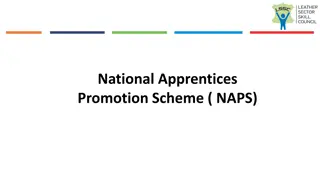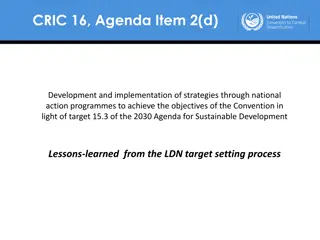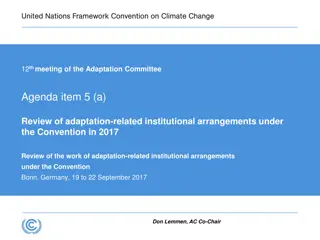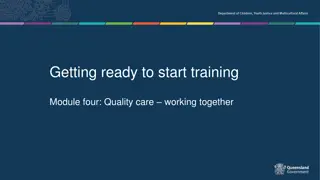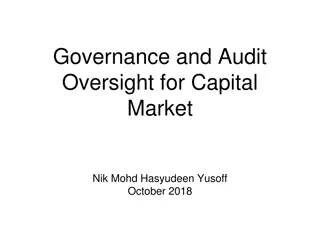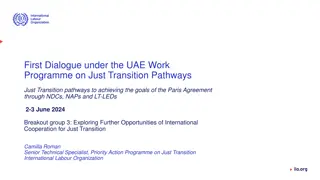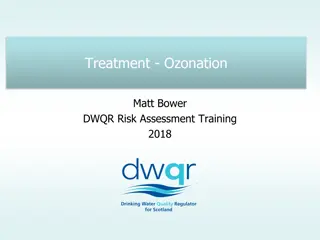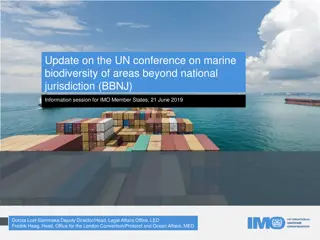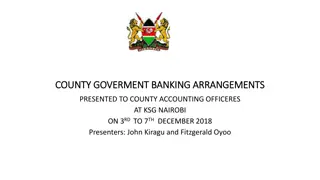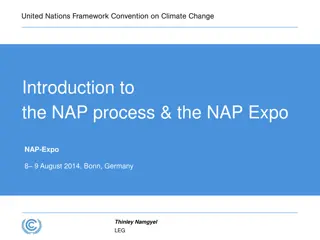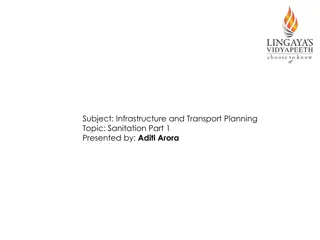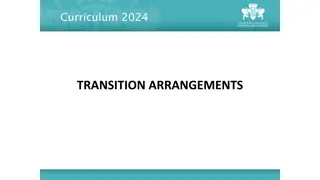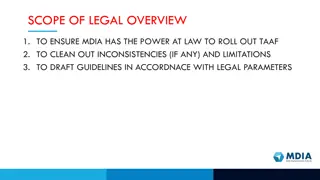Building Effective Institutional Arrangements for NAPs
Establishing clear institutional arrangements is crucial for successful National Adaptation Planning (NAP). This module provides insights into the importance and structure of these institutions, enhancing the capacity of countries to effectively adapt to climate change impacts.
Download Presentation

Please find below an Image/Link to download the presentation.
The content on the website is provided AS IS for your information and personal use only. It may not be sold, licensed, or shared on other websites without obtaining consent from the author. Download presentation by click this link. If you encounter any issues during the download, it is possible that the publisher has removed the file from their server.
E N D
Presentation Transcript
National Adaptation Plan (NAP) Country-level training Module II.2 Institutions for National Adaptation Planning Trainer: [Name] In cooperation with Slide 1
Overview of this module Clear institutional arrangements for NAPs are essential from the outset Institutions have a role in delivering specific NAP outcomes, such as coordination and prioritisation There are likely to be a number of key institutions that need to be involved (stakeholders) There are barriers that institutions commonly face in delivering NAP outcomes Yet these barriers have tried and tested solutions: how are you addressing those barriers? Slide 2
What can you expect to learn from this session? The key roles that public sector institutions should play in national adaptation planning and budgeting; Who the main stakeholders are likely to be and their interests; The most common institutional barriers to adaptation planning and how these can be overcome. Slide 3
NAP-relevant institutions Cabinet/senate/parliament Lead agency Departments and ministries Key sectors: Planning, Finance, Local Government National coordinating committee Technical group Wider reference group Slide 4
The primary role of NAP institutions is to coordinate different actors at multiple levels to achieve two key outcomes: Enabling factors Consensus on adaptation priorities (Key actor: Ministry of Planning or Economy); Sharing of knowledge for decision- making (Key actor: Research and Training institutions). Slide 5
How institutions lay the groundwork for effective NAPs Steps Activities Outcomes Element A: Laying the Ground Work (NAP Guidelines) Enhanced ability to prioritise through establishment of a multi- stakeholder committee (Example 1) Designate coordinating mechanism Initiating and launching the NAP process Create a national vision and mandate Relevant information and knowledge freely available to all sectors through the establishment of a national database (Example 2) Stocktaking: identifying available information Synthesize available knowledge on climate impacts Source: Adapted from UNFCCC - LEG (2012), NAP Technical Guidelines. Source: Adapted from UNFCCC LEG, 2012; NAP Technical Guidelines. Slide 6
Example 1: national stakeholder coordination in Indonesia Indonesia s National Council on Climate Change (DNPI) provides for multi-stakeholder and cross- sectoral coordination on climate change issues. During 2012 and 2013, fifteen government sectors engaged Source: UN CC: Learn, 2013 in developing and agreeing a National Climate Change Learning Strategy for the country. Slide 7
Example 2: sharing climate information in Mali When more climate information was needed by farmers about when and what to plant under changing climatic conditions, Met services, the Ministry of Agriculture and researchers collaborated with farmers to form a though a multidisciplinary working group, responsible Source: UN Photo, 2013 synthesising information on weather patterns. Slide 8
A mix of NAP stakeholders to consider Source: NAP Malawi, 2014. Slide 9
An example NAP process with key stakeholders F:\Backup 23_08_12\UNITAR\03_NAP\01_WORKSHOPS\03_GIZ\02_Draft Power Points\naptechguidelines_NAP_process.png Source: UNFCCC LEG, 2012; NAP Technical Guidelines. Slide 10
Zoom-in the NAP process: steering function Source: UNFCCC LEG, 2012; NAP Technical Guidelines. Slide 11
Institutional challenges and barriers for NAPs Fragmented national mandates on climate change; Uninformed viewpoints leading to polarized positions; Patchy political support from parliamentarians and thought leaders; Uncertainty over financial resources leads to loss of interest; Skewed availability of technical knowledge to handle climate change; Levels of communication and dialogue across government on climate change. What is the main challenge faced in your country? Slide 12
Responding to institutional challenges Issue 4: Limited dialogue Issue 1: Fragmented mandate Issue 2: Resource allocation Issue 3: Skewed knowledge Response: Use and strengthen existing coordination frameworks as much as possible Response: Be systematic about skills development and engage national training institutions Response: Engage high- level support from the outset; reach out to spending ministries Response: Lead entity engage key stakeholders early; be proactive; strong secretariat functions Slide 13
A climate change coordinating structure Malawi Existing structures New structures Source: UNITAR, 2015 Slide 14
What have we learned? Institutional clarity is important: get it right from the outset; Institutions for what? Coordination is the most fundamental service that institutions can provide for NAPs; Consider your key stakeholders both by sector and level of government national to local; Where there are challenges, there are solutions; What have you picked up from this session? Slide 15
Exercise part A: Institutional barriers and possible responses You are invited to specify 4 barriers of essential importance for the concrete situation of your country Find responses to overcome the constraints Orientate yourself on matrix II.2.1 Note down your findings on cards Slide 16
Exercise part B: Stakeholder mapping - I The relevant stakeholders names should first be written on cards using the colours as indicated: Primary stakeholder Veto player Secondary stakeholder Slide 17
Exercise part B: stakeholder mapping - II Place the cards on the prepared table and develop a stakeholder map Please reflect also the strength of influence of the stakeholder by positioning the cards: the closer to the centre, the stronger the influence Analyse the interactions between the stakeholders by using the following lines in the stakeholder map: Strong cooperation: Weak cooperation: Conflicting relationship: Slide 18
Exercise part C: Institutional set up Allocate the stakeholders, which you identified in the stakeholder map, according to the scheme II.2.2 Just take the relevant cards from the stakeholder map and place them in the scheme In a second step, reflect on adequate solutions for an organizational scheme for the NAP process (you might indicate arrows of cooperation) Slide 19
Imprint Published by Deutsche Gesellschaft f r Internationale Zusammenarbeit (GIZ) GmbH This presentation is part of a NAP country-level training that has been developed by GIZ on behalf of BMZ and in cooperation with the NAP Global Support Programme (NAP-GSP), in particular UNDP and UNITAR. Climate Policy Support Project Dag-Hammarskj ld-Weg 1-5 65760 Eschborn, Germany T +49 61 96 79-0 F +49 61 96 79-1115 The training is designed to support countries in setting up a National Adaptation Plan (NAP) process. It builds on the NAP Technical Guidelines developed by the Least- Developed Countries Expert Group (LEG). Contact E climate@giz.de I www.giz.de/climate You are welcome to use the slides, as long as you do not alter its content or design (including the logos), nor this imprint. If you have any questions regarding the training, please contact Michael Brossmann at GIZ. For questions related to the Technical Guidelines, please refer to the UNFCCC s NAP Central. Responsible Michael Brossmann, GIZ Authors Angus Mackay, Ilaria Gallo Picture credits Title: Indonesia stakeholder (UN: CC Learn, 2013), Mali Auditorium (UN Photo, 2013), NAP Cube (NAP Malawi, 2014), NAP process key stakeholders & Zoom-In (UNFCCC LEG, 2012), A climate change coordinating structure Malawi (UNITAR 2015) As a federally owned enterprise, the Deutsche Gesellschaft f r Internationale Zusammenarbeit (GIZ) GmbH supports the German Government in achieving its objectives in the field of international cooperation for sustainable development. GIZ also engages in human resource development, advanced training and dialogue. Slide 20



